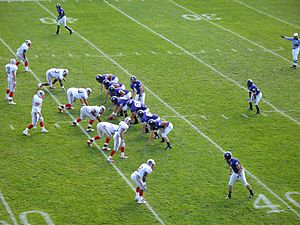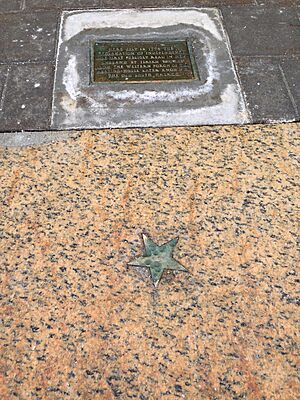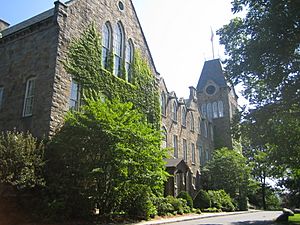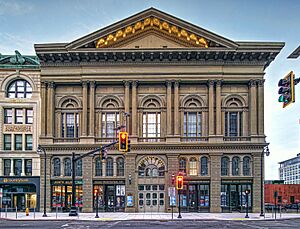Worcester, Massachusetts facts for kids
Quick facts for kids
Worcester, Massachusetts
|
|||
|---|---|---|---|
|
City
|
|||
|
Worcester city skyline
|
|||
|
|||
| Nickname(s):
The City of the Seven Hills, The Heart of the Commonwealth, Wormtown, Woo-town, The Woo
|
|||

Location within Worcester County
|
|||
| Country | United States | ||
| State | Massachusetts | ||
| County | Worcester | ||
| Region | New England | ||
| Historic colonies | Massachusetts Bay Colony Dominion of New England Province of Massachusetts Bay |
||
| Settled | 1673 | ||
| Incorporated as a town | June 14, 1722 | ||
| Incorporated as a city | February 29, 1848 | ||
| Named for | Worcester, Worcestershire | ||
| Government | |||
| • Type | Council–manager | ||
| Area | |||
| • City | 38.44 sq mi (99.57 km2) | ||
| • Land | 37.36 sq mi (96.76 km2) | ||
| • Water | 1.08 sq mi (2.81 km2) | ||
| Elevation | 480 ft (146 m) | ||
| Population
(2020)
|
|||
| • City | 206,518 (US: 114th) | ||
| • Density | 5,527.78/sq mi (2,134.27/km2) | ||
| • Urban | 482,085 (US: 87th) | ||
| • Urban density | 1,852.1/sq mi (715.1/km2) | ||
| • Metro | 862,111 (US: US: 69th) | ||
| Time zone | UTC−5 (Eastern) | ||
| • Summer (DST) | UTC−4 (Eastern) | ||
| ZIP Codes |
01601–01610, 01612–01615, 01653–01655
|
||
| Area code(s) | 508 / 774 | ||
| FIPS code | 25-82000 | ||
| GNIS feature ID | 0617867 | ||
Worcester (pronounced like WUUST-ər) is a big city in the state of Massachusetts, USA. It's the second largest city in Massachusetts and also the second largest in New England, after Boston. Worcester is about 40 miles (64 km) west of Boston.
The city is often called the "Heart of the Commonwealth" because it's close to the center of Massachusetts. A heart is even the official symbol of the city! Worcester is also known for its many hills, like Rome, Italy.
In the 1800s, Worcester grew into an important industrial city. Factories made machines, fabrics, and wire. Many people from Europe moved here to work. After World War II, manufacturing slowed down. But in the 1990s, the city started to grow again. New jobs in education, medicine, and technology helped Worcester become strong once more.
Today, Worcester is known for being a very diverse city. Many people from different countries live here, including Vietnamese, Brazilians, and Puerto Ricans. About 22% of the people in Worcester were born outside the United States. The city is also a center for learning, with eight colleges and universities.
Contents
- History of Worcester
- Geography of Worcester
- People of Worcester (Demographics)
- Economy and Jobs in Worcester
- Education in Worcester
- Culture and Fun in Worcester
- Sports in Worcester
- Religion in Worcester
- Media in Worcester
- Getting Around Worcester (Transportation)
- Healthcare in Worcester
- Sister Cities
- Images for kids
- See also
History of Worcester
Let's explore the interesting past of Worcester, from its early days to how it became the city it is today.
Early Settlements and Native Americans
Long ago, the area where Worcester is now was home to the Nipmuc tribe. They called the region Quinsigamond.
In 1673, English settlers came to Quinsigamond. They wanted to create a new Christian Indian town and an English settlement. In 1674, they bought land from the Nipmuc people. English traders and settlers began to live there.
However, there were wars between the Native Americans and the English settlers. The town was abandoned twice because of these wars, first in 1675 during King Philip's War, and again in 1702 during Queen Anne's War.
Finally, in 1713, Worcester was settled for good by Jonas Rice. The town was named after Worcester, England, and officially became a town on June 14, 1722. In 1731, it became the main town for Worcester County.
Worcester's Role in the American Revolution
Worcester played a big part in the start of the American Revolution. On September 6, 1774, over 4,600 local soldiers marched on Main Street. They wanted to stop the British court from meeting. This event, called the Worcester Revolt, was the first time British authority was overthrown in the American colonies without any fighting.
In 1775, a newspaper publisher named Isaiah Thomas moved his newspaper, Massachusetts Spy, from British-controlled Boston to Worcester. He kept publishing his paper throughout the war. On July 14, 1776, Thomas read the Declaration of Independence aloud in Worcester. This was the first public reading of it in Massachusetts.
Growth and Industry in the 1800s
In the early 1800s, Worcester started to become a manufacturing center. Factories that made textiles (cloth), shoes, and clothes opened along the Blackstone River.
The city's manufacturing really took off when the Blackstone Canal opened in 1828 and the railroad came in 1835. Worcester became a major transportation hub, and factories thrived.
Worcester officially became a city on February 29, 1848. Its growing industries attracted many immigrants from places like Ireland, Scotland, Germany, and Sweden. Later, people from Lithuania, Poland, Italy, and other countries also moved to Worcester. Many of them lived in new "three-decker" houses, which were first built in Worcester.
One important company was the Washburn & Moen Company, which became the largest wire manufacturer in the country. Worcester became famous for making machinery, wire products, and power looms.
Worcester is also known for many inventions and "firsts":
- Candlepin bowling was invented here in 1879 by Justin White.
- Esther Howland started the first line of Valentine's Day cards from her home in 1847.
- Loring Coes invented the first monkey wrench.
- In 1880, Lee Richmond pitched the first perfect game in Major League Baseball history for the Worcester Ruby Legs.
Changes and Recovery After World War II
After World War II, Worcester's manufacturing industries declined. Many jobs moved to other places. The city's population also dropped.
In 1953, a very strong tornado hit Worcester. It caused a lot of damage and killed 94 people. This was the deadliest tornado ever in Massachusetts.
In the late 1900s, Worcester's economy began to get better. New industries like biotechnology and healthcare grew. The UMass Medical School became a leader in medical research. Hospitals like Saint Vincent Hospital and UMass Memorial Health Care became major employers. Worcester's many colleges also helped bring new life to the city.
In 1999, a big fire at the Worcester Cold Storage & Warehouse Company killed six firefighters. This was a very sad event for the city.
Recent Growth and Investment
In recent years, people have shown new interest in downtown Worcester. This has led to new buildings and investments.
- The DCU Center arena and a Convention Center were built.
- Union Station reopened in 2000 after being renovated.
- The Hanover Theatre for the Performing Arts was created from an old theater.
- New campuses for colleges like Massachusetts College of Pharmacy and Health Sciences and Worcester Polytechnic Institute opened downtown.
- A big project called City Square brought new shops, offices, and homes to the downtown area.
Worcester has also welcomed many refugees in recent years. Over 2,000 refugees from more than 24 countries have found a new home here.
Geography of Worcester
Worcester is located in the middle of Massachusetts. It covers about 38.6 square miles (99.57 km²). The city is surrounded by several towns.
The Blackstone River starts in Worcester. It flows underground through the city center before coming out and continuing south. The Blackstone Canal used to connect Worcester to Providence, but it's not used anymore.
Worcester is famous for being built on seven hills, just like Rome. These hills include Airport Hill, Bancroft Hill, Belmont Hill, Grafton Hill, Green Hill, Pakachoag Hill, and Vernon Hill. There are actually even more hills in the city!
Worcester has many ponds and two main lakes: Indian Lake and Lake Quinsigamond. Lake Quinsigamond is a popular spot for competitive rowing and boating.
Worcester's Climate
Worcester has a typical New England climate. Summers are usually hot and humid. Winters are cold, windy, and snowy. Snow usually falls from late November to early April.
The city gets a lot of snow, more than places closer to the coast. This is because of its location and elevation, which makes it prone to big snowstorms called "Nor'easters." In 2015, a blizzard brought almost 32 inches (81 cm) of snow to the city in one day!
Even though extreme weather is rare, Worcester has experienced it. In 1938, a hurricane hit the city. And in 1953, a deadly tornado caused a lot of damage.
People of Worcester (Demographics)
Worcester is home to a diverse population. In 2020, the city had 206,518 people.
The city is known for its large immigrant population. Many people from Vietnam, Brazil, Albania, Puerto Rico, Ghana, and the Dominican Republic live here. About 22% of Worcester's residents were born outside the United States.
Economy and Jobs in Worcester
Worcester used to be a major manufacturing city, making things like machinery and wire. While manufacturing has decreased, some large companies like Norton Abrasives (now part of Saint-Gobain) and the David Clark Company (which makes equipment for pilots) are still here.
Today, a big part of Worcester's economy comes from services, especially education and healthcare. The city's many colleges and universities, along with hospitals like UMass Memorial Health Care and Saint Vincent Hospital, provide many jobs.
Hanover Insurance has its main office in Worcester. Polar Beverages, a large independent soft-drink company, is also based here.
Worcester is also becoming a hub for biotechnology and technology. The University of Massachusetts Medical School and Worcester Polytechnic Institute are leaders in these fields.
Top Employers in Worcester
Here are some of the biggest employers in Worcester:
- UMass Memorial Health Care
- City of Worcester
- University of Massachusetts Medical School
- Reliant Medical Group
- Saint Vincent Hospital
- Hanover Insurance
- Saint-Gobain
- Seven Hills Foundation
- Worcester Polytechnic Institute
- Community Healthlink
Education in Worcester
Worcester is a great place for learning, with many schools and colleges.
Schools for Kids
The Worcester Public Schools system teaches over 25,000 students from pre-kindergarten to 12th grade. There are many elementary, middle, and high schools.
Some of the public high schools include Worcester Technical High School, South High Community School, North High School, and Doherty Memorial High School. The Massachusetts Academy of Math and Science at WPI is a special public high school for talented students.
There are also many private schools in Worcester, like Worcester Academy, which was founded in 1834, and Bancroft School.
Colleges and Universities
Worcester is home to eight colleges and universities, attracting many students to the city:
- Assumption University: A Catholic college founded in 1904. It has the largest campus in Worcester.
- Clark University: Started in 1887, it was first a school just for graduate students. Now it has undergraduate students too. Famous people like Sigmund Freud and Robert H. Goddard (a rocket scientist) visited or studied here.
- College of the Holy Cross: The oldest Catholic college in New England, founded in 1843. Many famous people have graduated from here, including Anthony Fauci and Supreme Court Justice Clarence Thomas.

- Massachusetts College of Pharmacy and Health Sciences: Offers programs in pharmacy, nursing, and other health fields.
- Quinsigamond Community College: Provides associate degrees and certificates to thousands of students each year.
- University of Massachusetts Medical School: One of the top medical schools in the country. A scientist named Craig Mello won a Nobel Prize for Medicine while working here.
- Worcester Polytechnic Institute (WPI): A private university focused on engineering and science. Founded in 1865, it was one of the first engineering schools in the U.S. Robert Goddard, the "father of modern rocketry," graduated from WPI.
- Worcester State University: A public university offering many different majors.
These colleges often work together through the Colleges of Worcester Consortium. They share resources and even have a shuttle bus for students.
Culture and Fun in Worcester
Worcester has a unique culture, part of the bigger New England culture. People who aren't from here often mispronounce the city's name. It's pronounced "WOOS-tuh" or "WISS-tuh."
The city has many neighborhoods with different ethnic backgrounds. For example, Shrewsbury Street is known as "Little Italy" and has many popular restaurants. The Canal District, once an old European neighborhood, is now a lively area with bars and clubs.
Worcester is also famous for its "lunch car diners." These are small, classic restaurants that look like train cars. Many were built by the Worcester Lunch Car Company. You can still visit classic diners like Boulevard Diner and Miss Worcester Diner.
There are many arts and community events in Worcester:
- stART on the Street is a yearly festival that shows off local art.
- The Worcester Music Festival and New England Metal and Hardcore Festival are held every year.
- The Worcester County St. Patrick's Parade is one of the biggest St. Patrick's Day celebrations in Massachusetts.
Worcester is the largest center for the arts in Massachusetts outside of Boston.
- Mechanics Hall, built in 1857, is a very old concert hall known for its amazing sound.
- The Hanover Theatre for the Performing Arts hosts many Broadway shows.
- The DCU Center arena holds large concerts and events.
- The Worcester Youth Orchestras is one of the oldest youth orchestras in the country.
The nickname "Wormtown" came from the city's strong underground rock music scene, but now it's used to refer to the city itself.
The city's official symbol is a heart, which comes from its location as the "Heart of the Commonwealth." It's also said that the first mass-produced Valentine's Day cards were made here by Esther Howland. Another famous symbol is the yellow "smiley face," invented by Worcester native Harvey Ball. You can see this design in art and on merchandise around the city.
Cool Places to Visit in Worcester
Worcester has over 1,200 acres (485 hectares) of public parks.
- Elm Park, designed in 1854, and the City Common are both historic parks.
- The largest park is Green Hill Park, which has 549 acres (222 hectares). The Massachusetts Vietnam Veterans Memorial is located here.

- The New England Botanic Garden at Tower Hill is a beautiful garden just outside the city.
- The Worcester Historical Museum teaches about the city's history.
- The American Antiquarian Society has one of the largest collections of early American history in the world.
- The Worcester Art Museum is the second largest art museum in New England. It now also displays the collection from the former Higgins Armory Museum, which was dedicated to arms and armor.
The Worcester Memorial Auditorium is a famous building. Built in 1933 as a tribute to World War I veterans, it has hosted many concerts and sports events. It's currently being updated to be a modern event center.
Sports in Worcester
Worcester has a lively sports scene!
Since 2021, Worcester has been home to the Worcester Red Sox, also known as the "WooSox." They are the Triple-A team for the Boston Red Sox and play at Polar Park.
Worcester was also home to Marshall Walter ("Major") Taylor, a famous African American cyclist. He won a world championship in 1899 and was nicknamed the Worcester Whirlwind.
Lake Quinsigamond is a popular place for competitive rowing. Many colleges and high schools hold races here, including the Eastern Sprints. In 1952, the lake even hosted the Olympic rowing trials!

The city is home to the Worcester Railers, an ECHL hockey team. Before them, the Worcester Sharks and Worcester IceCats also played here.
Worcester also has an indoor football team, the Massachusetts Pirates, who play at the DCU Center.
Candlepin bowling was invented in Worcester in 1880.
The Ryder Cup golf tournament had its first official event at the Worcester Country Club in 1927.
Worcester's colleges have strong sports teams. The College of the Holy Cross plays in NCAA Division 1. Their basketball team, the Holy Cross Crusaders, won national championships in 1947 and 1954, led by future NBA stars Bob Cousy and Tom Heinsohn.
Religion in Worcester
Worcester has many different religious communities. Most people in Worcester County report having no religious affiliation, but Catholicism is the largest reported religion.
The first Catholics came to Worcester in 1826. They were mostly Irish immigrants who helped build the Blackstone Canal. The first Catholic church, Christ's Church (now St. John's), was built in 1834. The Roman Catholic Diocese of Worcester was created in 1950.
Worcester also has a Greek Orthodox Cathedral, St. Spyridon, founded in 1924.
There is a dedicated Jewish population with several synagogues, including Temple Emanuel Sinai and Congregation Beth Israel.
The first Armenian Church in the Western Hemisphere was built in Worcester in 1890. It's now known as the Armenian Church of Our Savior.
Worcester is also home to America's largest community of Mandaeans, who are refugees from Iraq.
Media in Worcester
The Telegram & Gazette is Worcester's only daily newspaper. It's often called "the Telegram" or "the T and G."
Worcester also has several radio stations, including WTAG and WXLO. There's also a community cable TV station, WCCA-TV.
Getting Around Worcester (Transportation)
Worcester is connected by several major highways. Interstate 290 goes through the city, and other interstates like I-190 and I-90 are nearby.

Union Station is a beautiful train station that was restored in 2000. It's a hub for commuter trains to Boston and also an Amtrak stop for trains going to Chicago.
The Worcester Regional Transit Authority (WRTA) runs the city's bus system. Buses travel within Worcester and to nearby towns. You can also find long-distance bus services like Peter Pan Bus Lines at Union Station.
Worcester Regional Airport (KORH) is located on one of Worcester's highest hills. It has two runways and a modern terminal. Several airlines, including jetBlue and Delta Air Lines, offer flights from this airport.
Healthcare in Worcester
Worcester has excellent healthcare facilities.
In 1830, the Worcester State Insane Asylum Hospital was created. It was one of the first public hospitals in the U.S. to help people with mental health issues, especially those who couldn't afford private care.
The University of Massachusetts Medical School is a top medical school known for its research. It works closely with UMass Memorial Health Care, a large hospital system. Saint Vincent Hospital is another major hospital in downtown Worcester.
Reliant Medical Group is a large private medical group that offers many different types of medical care. They also created Fallon Community Health Plan, a big health insurance company based in Worcester.
Sister Cities
Worcester has special connections with other cities around the world, called "sister cities":
- Worcester, United Kingdom (1998)
- Afula, Israel
- Piraeus, Greece (2005)
- Pushkin, Saint Petersburg, Russia (1987)
Images for kids
See also
 In Spanish: Worcester (Massachusetts) para niños
In Spanish: Worcester (Massachusetts) para niños






















